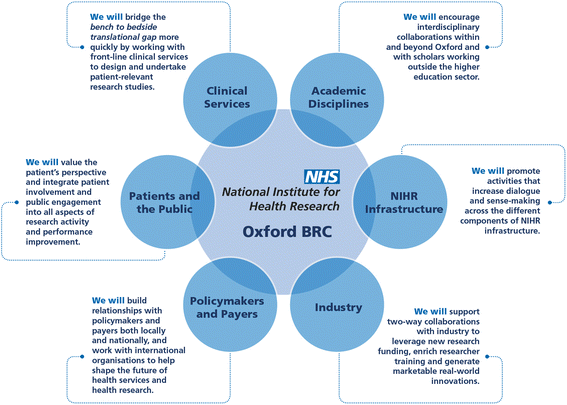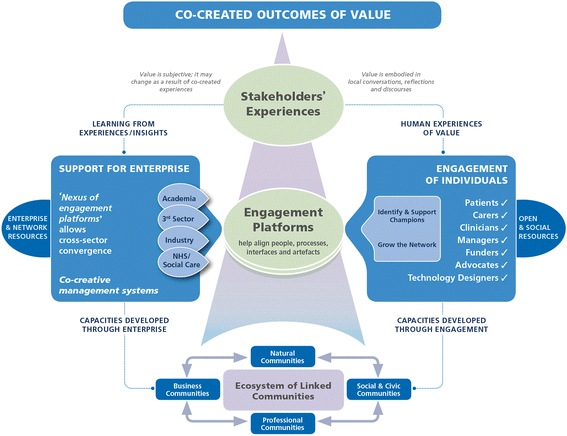Maximising value from a United Kingdom Biomedical Research Centre: study protocol
- PMID: 28806989
- PMCID: PMC5556344
- DOI: 10.1186/s12961-017-0237-1
Maximising value from a United Kingdom Biomedical Research Centre: study protocol
Abstract
Background: Biomedical Research Centres (BRCs) are partnerships between healthcare organisations and universities in England. Their mission is to generate novel treatments, technologies, diagnostics and other interventions that increase the country's international competitiveness, to rapidly translate these innovations into benefits for patients, and to improve efficiency and reduce waste in healthcare. As NIHR Oxford BRC (Oxford BRC) enters its third 5-year funding period, we seek to (1) apply the evidence base on how best to support the various partnerships in this large, multi-stakeholder research system and (2) research how these partnerships play out in a new, ambitious programme of translational research.
Methods: Organisational case study, informed by the principles of action research. A cross-cutting theme, 'Partnerships for Health, Wealth and Innovation' has been established with multiple sub-themes (drug development, device development, business support and commercialisation, research methodology and statistics, health economics, bioethics, patient and public involvement and engagement, knowledge translation, and education and training) to support individual BRC research themes and generate cross-theme learning. The 'Partnerships' theme will support the BRC's goals by facilitating six types of partnership (with patients and citizens, clinical services, industry, across the NIHR infrastructure, across academic disciplines, and with policymakers and payers) through a range of engagement platforms and activities. We will develop a longitudinal progress narrative centred around exemplar case studies, and apply theoretical models from innovation studies (Triple Helix), sociology of science (Mode 2 knowledge production) and business studies (Value Co-creation). Data sources will be the empirical research studies within individual BRC research themes (who will apply separately for NHS ethics approval), plus documentary analysis and interviews and ethnography with research stakeholders. This study has received ethics clearance through the University of Oxford Central University Research Ethics Committee.
Discussion: We anticipate that this work will add significant value to Oxford BRC. We predict accelerated knowledge translation; closer alignment of the innovation process with patient priorities and the principles of responsible, ethical research; reduction in research waste; new knowledge about the governance and activities of multi-stakeholder research partnerships and the contexts in which they operate; and capacity-building that reflects the future needs of a rapidly-evolving health research system.
Keywords: Biomedical Research Centres; Health policy; Health research policy; Health technology development; Innovation policy; Knowledge production; National Institute for Health Research; Research on research; Research partnerships.
Conflict of interest statement
Consent for publication
Not applicable.
Competing interests
All authors have completed the unified competing interest form at
Publisher’s Note
Springer Nature remains neutral with regard to jurisdictional claims in published maps and institutional affiliations.
Figures




Similar articles
-
A large National Institute for Health Research (NIHR) Biomedical Research Centre facilitates impactful cross-disciplinary and collaborative translational research publications and research collaboration networks: a bibliometric evaluation study.J Transl Med. 2021 Nov 27;19(1):483. doi: 10.1186/s12967-021-03149-x. J Transl Med. 2021. PMID: 34838033 Free PMC article.
-
Markers of achievement for assessing and monitoring gender equity in a UK National Institute for Health Research Biomedical Research Centre: A two-factor model.PLoS One. 2020 Oct 14;15(10):e0239589. doi: 10.1371/journal.pone.0239589. eCollection 2020. PLoS One. 2020. PMID: 33052933 Free PMC article.
-
The future of Cochrane Neonatal.Early Hum Dev. 2020 Nov;150:105191. doi: 10.1016/j.earlhumdev.2020.105191. Epub 2020 Sep 12. Early Hum Dev. 2020. PMID: 33036834
-
Towards achieving interorganisational collaboration between health-care providers: a realist evidence synthesis.Health Soc Care Deliv Res. 2023 Jun;11(6):1-130. doi: 10.3310/KPLT1423. Health Soc Care Deliv Res. 2023. PMID: 37469292
-
The effectiveness, cost-effectiveness and policy processes of regulatory, voluntary and partnership policies to improve food environments: an evidence synthesis.Public Health Res (Southampt). 2024 Sep;12(8):1-173. doi: 10.3310/JYWP4049. Public Health Res (Southampt). 2024. PMID: 39323285
Cited by
-
Perceptions of gender equity and markers of achievement in a National Institute for Health Research Biomedical Research Centre: a qualitative study.Health Res Policy Syst. 2022 Sep 24;20(1):102. doi: 10.1186/s12961-022-00904-4. Health Res Policy Syst. 2022. PMID: 36153620 Free PMC article.
-
What happens after James Lind Alliance Priority Setting Partnerships? A qualitative study of contexts, processes and impacts.Res Involv Engagem. 2020 Jul 11;6:41. doi: 10.1186/s40900-020-00210-9. eCollection 2020. Res Involv Engagem. 2020. PMID: 32670611 Free PMC article.
-
The price of progress: Funding and financing Alzheimer's disease drug development.Alzheimers Dement (N Y). 2018 Jun 13;4:330-343. doi: 10.1016/j.trci.2018.04.008. eCollection 2018. Alzheimers Dement (N Y). 2018. PMID: 30175227 Free PMC article.
-
A large National Institute for Health Research (NIHR) Biomedical Research Centre facilitates impactful cross-disciplinary and collaborative translational research publications and research collaboration networks: a bibliometric evaluation study.J Transl Med. 2021 Nov 27;19(1):483. doi: 10.1186/s12967-021-03149-x. J Transl Med. 2021. PMID: 34838033 Free PMC article.
-
Electrocardiographic Imaging for Atrial Fibrillation: A Perspective From Computer Models and Animal Experiments to Clinical Value.Front Physiol. 2021 Apr 30;12:653013. doi: 10.3389/fphys.2021.653013. eCollection 2021. Front Physiol. 2021. PMID: 33995122 Free PMC article. Review.
References
-
- Rycroft-Malone J, Burton C, Wilkinson JE, Harvey G, McCormack B, Baker R, et al. Collective action for knowledge mobilisation: a realist evaluation of the Collaborations for Leadership in Applied Health Research and Care. Health Services and Delivery Research. Southampton (UK): NIHR Journals Library; 2015. - PubMed
-
- National Institute for Health Research. Biomedical Research Centres. http://www.nihr.ac.uk/about-us/how-we-are-managed/our-structure/infrastr.... Accessed 3 March 2017.
MeSH terms
Grants and funding
LinkOut - more resources
Full Text Sources
Other Literature Sources
Research Materials

